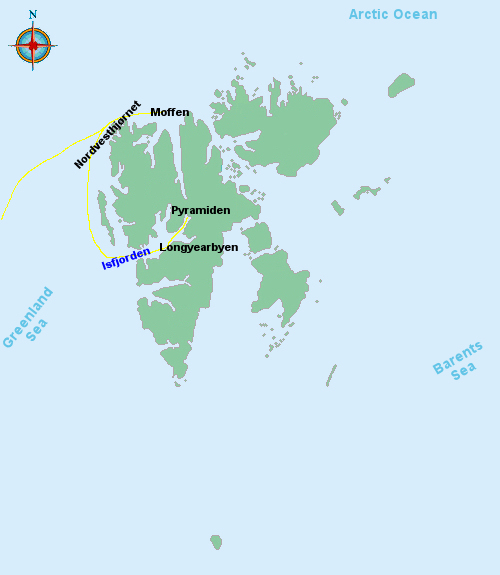Svalbard

Historie
The Dutchman Willem Barentsz made the first indisputable discovery of Svalbard in 1596, in an attempt to find
the Northeast Passage. In 1604, an English ship landed at Bjørnøya and started hunting walrus; annual
expeditions followed.
From 1611, Spitsbergen became a base for whaling, where they targeted the Bowhead Whale.
Because of the lawless nature of the area, English, Danish, Dutch and French companies and authorities tried to use
force to keep out other countries' fleets.
Smeerenburg was one of the first settlements, established by the Dutch in 1619. Smaller bases were also built
by the English, Danish and French. At first the outposts were merely summer camps, but from the early 1630s, a few
individuals started to overwinter. Whaling at Spitsbergen lasted until the 1820s, when the Dutch, British and Danish
whalers moved elsewhere in the Arctic.
By the late 17th century, Russian hunters arrived; they overwintered to a greater extent and hunted land mammals such
as the Polar Bear and Fox. After British ships destroyed most of the Russian fleet in 1812, Russian activity on Svalbard
diminished, and became non-existent from the 1820s.
By the 1890s, Svalbard had become a destination for Arctic tourism, coal deposits had been found and the islands were
being used as a base for Arctic exploration. The first mining was done along Isfjorden by Norwegians in 1899; by 1904,
British interests had established themselves in Adventfjorden and started the first all-year operations. Production in
Longyearbyen commenced by American interests in 1908; and Store Norske established itself in 1916, as did other
Norwegian interests during the war, in part by buying American interests.
Discussions to establish the sovereignty of the archipelago commenced in the 1910s, but were interrupted by World War I.
On 9 February 1920, following the Paris Peace Conference, the Svalbard Treaty was signed, granting full
sovereignty to Norway. However, all signatory countries were granted non-discriminatory rights to fishing, hunting and
mineral resources.
The treaty took effect on 14 August 1925, at the same time as the Svalbard Act regulated the
archipelago and the first governor, Johannes Gerckens Bassøe, took office.
I have visited Svalbard in august 2013.
These are the places i have been in Svalbard
Isfjorden
Longyearbyen
Pyramiden
Nordvesthjørnet
Moffen
Please let me know when you're having questions.
i would be pleased to help you.
Things to do and other tips
